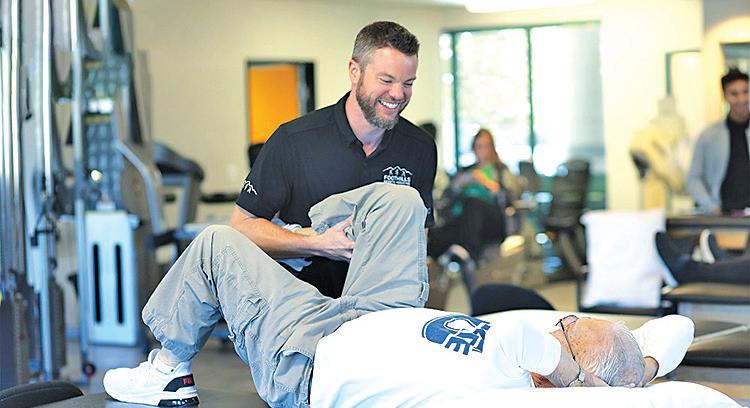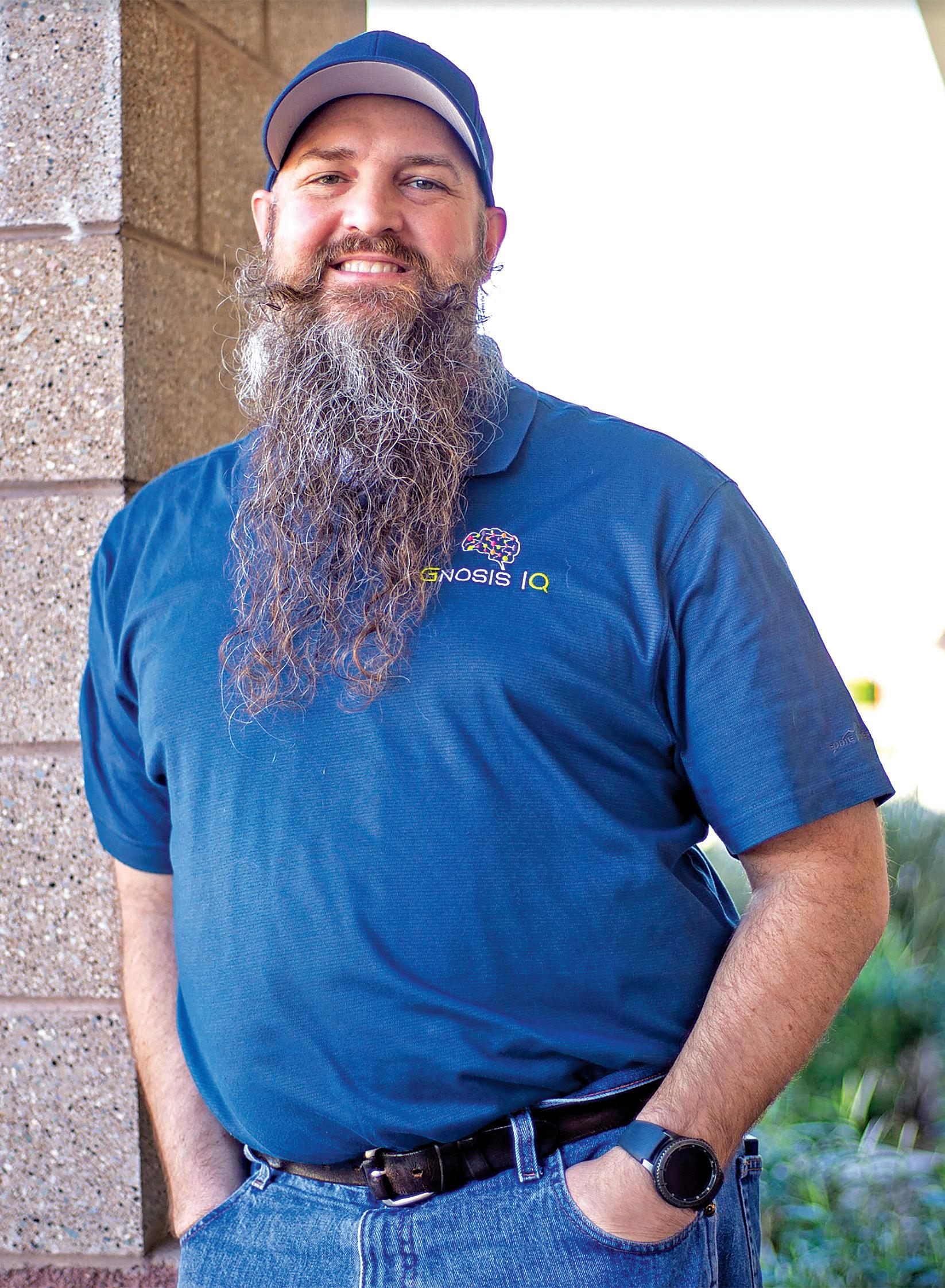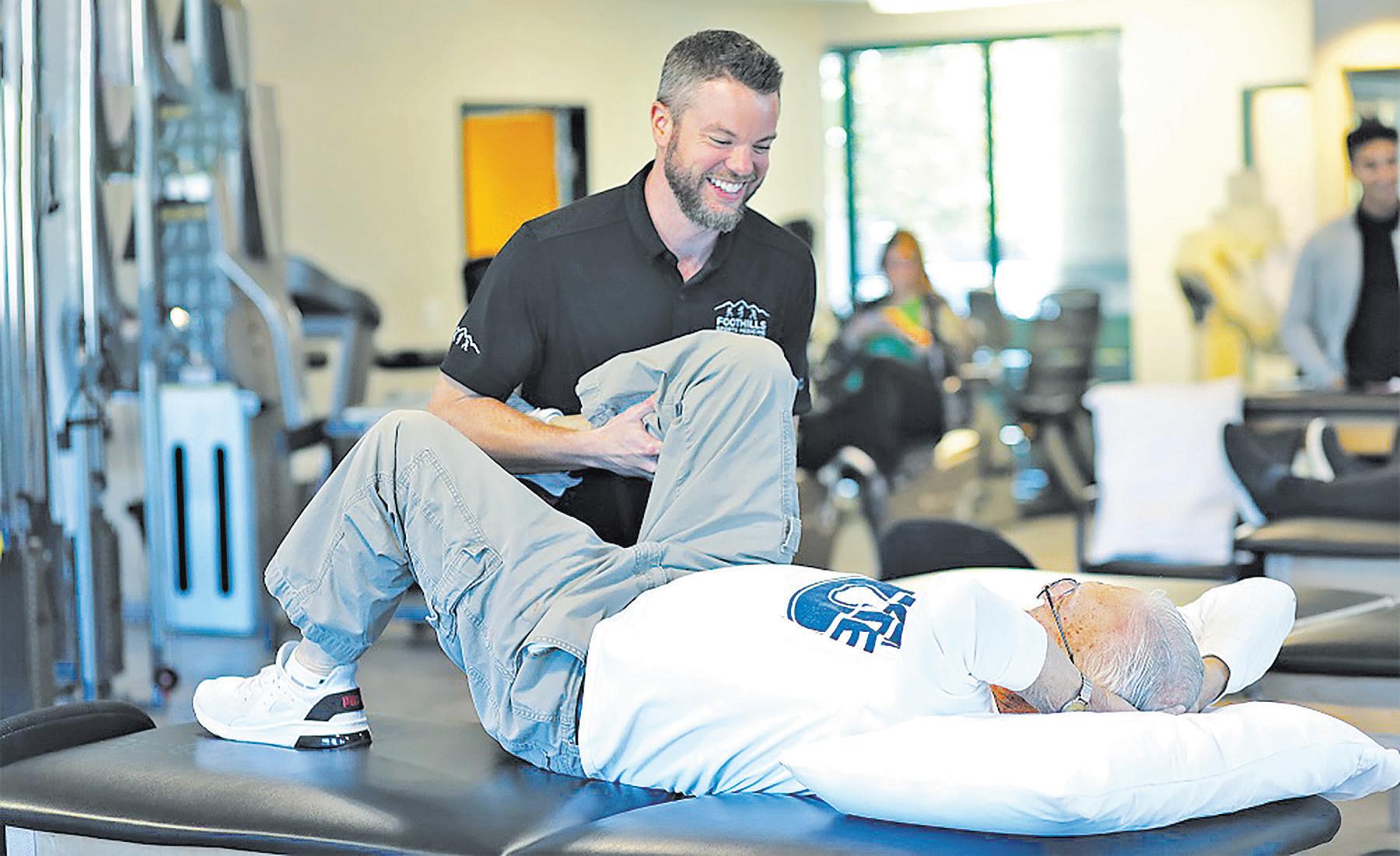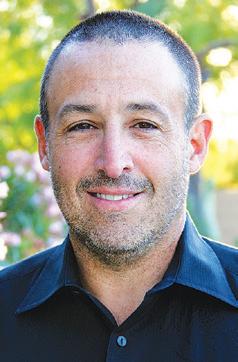Mayor looks back, ahead




The Queen Creek Unified Governing Board last week unanimously approved a 2% raise for its certified employees, and increased the base pay for starting teachers from $50,000 to $53,000 annually.
Administration officials said the raise would help keep Queen Creek Unified competitive with other Valley districts that have


made similar salary adjustments thanks to a state budgetary surplus.

“If a current teacher is below that base salary, then they will be brought to the $53,000 base before the approved raise is applied,” said Chief Financial Officer Jessica Johnston.
Johnston said the board discussed the compensation package in a special session last month.
“I was excited that we were able to give teachers a raise of 2%,” board member James

Knox told the Tribune. “I wish in the private sector we were getting 2% raises.
“Raising the base pay is a great start for new teachers and any additional money we can provide for our education process is a good thing,” he added. “Teachers are the most important resource we have.”
Like other school districts in Arizona, Queen Creek is using a portion of the state’s
see RAISES page 5

To keep pace with the town’s growth, the Queen Creek Fire and Medical Department will likely expand beyond its current roster of five fire stations perhaps more quickly than originally thought.

huge negative challenge,” he added. “It’s just making sure that we are providing the adequate services that we need for Queen Creek residents.
The Town of Queen Creek Recreation Department jump-started Valentine’s Day observances Feb. 3 with a “Love Bug” dance for children 3-12 and their parents. The girls donned their holiday best and they and their parents enjoyed games, crafts and, of course, a lot of dancing. (Quinton Kendall/Tribune Contributor)

“There is a possibility that with the growth that Queen Creek continues to experience that at some point in the future Queen Creek could add up to four more fire stations based on the growth potential,” Fire Chief Vance Gray said.
“I’m not framing this as a
“So, we watch that very closely. The biggest challenge is ensuring that we are keeping up with growth and keeping up with the way that the population is increasing.”
The department is marking its 15th anniversary this year.
It typically sees a consistent 7% to 10% increase in the number of fire and medical calls year over year, Gray said, and that
see FIRE page 6




































The town public works director has recommended a traffic roundabout at the intersection of Hawes and Queen Creek roads, replacing a T-intersection at what officials say has become a dangerous location.
Currently, traffic headed northbound on Hawes Road does not stop and there is only a stop sign for eastbound vehicles on Queen Creek Road.
A typical T-intersection has nine so called “conflict points,” according to Public Works Director Mohamed Youssef, whereas a traffic roundabout has only six, reducing the chances of an accident as well as the severity of a collision when one occurs.
“It’s just like a relationship,” Youssef said. “Less conflict points, happy people. In an intersection, less conflict points more safe and efficient operation at the intersection.”
Youssef said the Insurance Institute
for Highway safety claims that roundabouts reduce overall collisions by 37%, injury collisions by 75%, fatal collisions by 90% and pedestrian injuries by 40%.
A roundabout also creates fewer environmental impacts, Youssef said, because there are lower emissions and gas consumption if cars keep moving, like they do in a traffic roundabout. They also impose fewer construction, maintenance, and electricity costs, too.
“You don’t have the signal equipment. You don’t have a whole lot of expense that comes with a signal, a controller and cabinet and all of that,” he said. “The roundabout is the way to go.”
A center “splitter island” and yield sign separate a roundabout from a traffic circle and is a more modern option, according to Youssef.
The roundabout would be paid out of the town’s Capital Improvement Project budget. Work on this intersection is part of the Hawes Road upgrade that runs from Ocotillo to Rittenhouse roads.
The plan has widespread support from

the council.
“I’m from South Texas and we have roundabouts everywhere,” said Councilman Travis Padilla. “And I absolutely love them. Traffic is important to me.
“Increasing the flow of traffic in Queen Creek. It’s important because it keeps the traffic moving, and it keeps it moving at a low speed,” he added. “It’s fantastic. I’m going to continue to encourage you to look for any areas where this makes sense to do roundabouts in Queen Creek.”
Vice Mayor Jeff Brown expressed support for the project, but said the town should consider a robust social media campaign to educate drivers who may be unfamiliar or uncomfortable with roundabouts about the fact that they are coming and can be beneficial.
“If we could have a ‘Your tax dollars at work’ type sign that said ‘hey we’re saving you money on fuel, lower construction costs and we are mitigating your risk of significant injury,” Brown said.
“I think that might go a long way to
help folks understand why we would be entertaining these things. It’s a very straightforward proposal and has some very significant benefits.”
Councilman Bryan McClure added, “Although there may be a learning curve for some drivers on how to handle it, I’m really excited about this and in support of it.”
Noting the reduction in injury collisions and agreeing that a public outreach campaign will be important, Mayor Julia Wheatley also voiced her support.
“It looks like you’ve made roundabout fans of all of us,” Wheatley told Youssef. “You have a bunch of fans up here.”
Once it is completely drafted, the roundabout plan will come before Council for a final vote.
CONTACT INFORMATION
Main number: 480-898-6500
Advertising: 480-898-5624
Circulation: 480-898-5641
Publisher: Steve T. Strickbine
Vice President: Michael Hiatt
ADVERTISING DEPARTMENT
Display Advertising: 480-898-6309
Classifieds/Inside Sales: TJ Higgins | 480-898-5902 tjhiggins@TimesLocalMedia.com
Steve Insalaco | 480-898-5635 sinsalaco@TimesLocalMedia.com
Advertising Sales Executive: Jane Meyer | 480-898-5633 jane@TimesLocalMedia.com
NEWS DEPARTMENT
Executive Editor: Paul Maryniak | 480-898-5631 pmaryniak@TimesLocalMedia.com
Managing Editor: Cecilia Chan | 480-898-5613 cchan@TimesLocalMedia.com
Reporters: Mark Moran | 480-898-5601 | mmoran@TimesLocalMedia.com
Ken Sain | 928-420-5341 ksain@TimesLocalMedia.com
Sports Editor: Zach Alvira | 480-898-5630 | zalvira@ TimesLocalMedia.com
Photographer: Dave Minton | dminton@TimesLocalMedia.com
Design/Production Supervisor: Shannon Mead | smead@TimesLocalMedia.com
Design: Ruth Carlton | rcarlton@TimesLocalMedia.com


Circulation: 623-535-8439
Circulation Director: Aaron Kolodny | aaron@phoenix.org
Distribution Manager: Brian Juhl | brian@timeslocalmedia.com

 BY MARK MORAN Tribune Staff Writer
BY MARK MORAN Tribune Staff Writer
Mayor Julia Wheatley reflected on Queen Creek’s successes and its losses in 2022 while looking forward to 2023 year in her first State of the town address Feb. 7.
“There is so much to look forward to in 2023,” Wheatley said. “Construction of the town’s second hotel, Homewood Suites in Town Center, an update to our Town Center plan, the opening of a number of new businesses, including Dave and Busters, the launch of our emergency transportation service, or ambulance services, an update to our utility billing system, continued road improvements, and the one that I am most particularly excited about, the opening of Frontier Family Park.”
Joined in a video by her Town Council colleagues, Wheatley paid tribute to the late Mayor Gail Barney, who died in June, saying he “dedicated his life to service.”
“He and his family have been staples to our community and we are so thankful for the impact he made and will continue to make on the hometown he loved so
much,” she said.
She also saluted retired Town Manager John Kross, and said, “ “Both Mayor Barney and John Kross were instrumental in so many of the strategic decisions that helped shape this community.
“They both leave a tremendous legacy here in Queen Creek, and I know we will continue the positive momentum they both worked so hard to create.”
She and Councilwoman Leah Martineau hailed the launch of Queen Creek’s police department, one of the town’s most significant achievements of 2022 after years of strategic planning.
Vice Mayor Jeff Brown noted, “Not only did the police department launch, but the town opened two permanent fire stations.
“Permanent fire station number two opened in the southwest area of town and fire station opened in the southeast area of town,” he said. “These stations include state of the art technology, enhancing service to residents and protecting the health of our firefighters.”
Queen Creek has relied on American Medical Response, a private company, for medical emergencies requiring an
ambulance. But that is likely to change this year as Town Council approved the formation of Queen Creek’s own ambulance service.
“This will allow consistent ambulance coverage, reduce response times and opportunities to partner with our neighboring jurisdictions for enhanced efficiencies and coverage,” Brown said.
Councilmember Robin Benning highlighted a series of cost-saving moves made in 2022.
They included freezing property taxes for existing homeowners, absorbing the $93,000 cost of street light operation that had previously been paid by property taxes, and a “water replenishment district reduction that exceeds $600,000,” Benning said.
Benning also featured the town’s approval of the first large scale industrial development, the Germann Commerce Park, a 1-million square foot industrial facility scheduled to break ground early this year.
Benning also made mention of rezoning action Council took to encourage growth of Queen Creek’s unique Agritainment District, highlighted by Schnepf Farms, The Olive Mill restaurant and Sossamon Farms.
The video also highlighted a host of public works projects, from roads and intersection construction to increased access to State Route 24, and dozens of new traffic signals.
Queen Creek made two significant water rights purchases last year that were also noted in the video.
The first, a $21-million deal with GSC Farms of Cibola would result in 2,033 acre feet of water being routed away from Cibola and to Queen Creek every year to bolster the local 100-year underground water supply.
The second was a $30-million deal to buy water rights from the Harquahala underground aquifers west of Phoenix and route that water to Queen Creek.
La Paz, Mohave and Yuma counties have sued the U.S. Bureau of Reclamation in federal court to stop that deal until more environmental assessments are done. The case is pending a March 8th hearing.
“In addition to conserving water, the town is continuing to seek opportunities
$5-billion revenue surplus that lawmakers earmarked for K-12 schools last fall to pay for teacher and staff compensation increases.
This is the seventh consecutive year the district has increased teacher and staff salaries. The latest raise came last September.
“With the state’s historic increase to school funding this past fall, the board approved a raise package that passed all the additional monies on to our employees,” Johnston said.
“Certified and administrative staff received a 5% raise and classified (staff) received an additional $2 per an hour. All employee groups also received equity adjustments,” she said of last September’s raise.

The new increase for salaried staff and an extra dollar per hour for classified staff raise is projected to offset an inflationary increase of 2% for the K-12 public education system, Johnston quoted the
governor’s proposed budget as saying.
As with other public services in town, Queen Creek schools are racing to keep up with student enrollment as a result of booming population growth.
Voters have rejected bond measures in each of the past two elections, the most recent a $198-million initiative that would have helped pay for school expansions and upgrades.
As a result of that bond measure de-
feat, the district is spending $5.5-million on portable classrooms to keep pace with student enrollment.
“Queen Creek Unified is projected to grow by approximately 600 students in the 2023-24 school year,” Johnston said. “The result of the student growth and inflationary funding is expected to increase QCUSD’s (Maintenance and Operations) budget by $4.5-million.
“Due to the growth that we are expe-
riencing in our student population, the hiring of additional certified and classified staff will be necessary for next year,” Johnston said.
She added utility and health care costs are going up, as are capital expenses like furniture, equipment, and software licenses, which will also require additional funding.
But for now, the focus remains on personnel.
“This recommendation allows the district to provide additional compensation for all employee groups as the district continues to grow,” Johnston said.
The overall budgetary impact of the salary hikes totals just under $2.2-million, according to district records.
“I just want to say thank you,” said board member Samantha Davis. “I feel like you guys constantly do what you can to try to find money for teachers any chance we can get.”
The district’s overall projected budget for the 2023-2024 year is just shy of $108 million.

110” wide x 95” high List Price $12,858
SALE $6,429
FIRE from page 1
rate is likely to stay the same even as the town expands and the department grows to meet the population’s needs.

“That has been consistent throughout our existence,” Gray said. “I would say that in 2008 we were probably running between 1,500 and 2,000 a year. Currently, we are probably going to hit the 6,000 mark this year.”
The increase in call numbers does not tell the full story.
The Great Recession essentially shuttered any type of economic expansion or growth in the five years between 2008 and 2013, including that of the Fire and Medical Department.
So, Queen Creek Fire and Medical has largely tripled its call volume in just under a decade, between 2013 and today.
“Nothing has really changed in terms of the types of calls that we run,” Gray said. “It’s just there is more people moving to Queen Creek and living here and there are also more commercial businesses coming in so that is adding to the call volume, as well.”

Fifteen years ago, Queen Creek’s population was only about 24,000. Today, it
tops 71,000, according to the Maricopa Association of Governments. As one of the




fastest growing suburbs in the county, it is placing more demands on public services.


The Fire and Medical Department started in 2008 with 30 employees, two stations and a pair of fire trucks. Now, with firefighters and support staff, there are 81 employees, 12 emergency response vehicles including fire trucks, and five stations located strategically across town, based on population growth and demand.
“The growth of the town is what drove the number of fire stations,” Gray said.
He added the department’s master plan predicted the need for the five existing stations, but has since been updated to call for up to four more.
“We are so proud of all the dedicated men and women who are committed to the safety of our community, and how far we have come as an agency over the last 15 years,” Gray said. “We appreciate the continued support from our residents and the Council.”
Gray said Queen Creek also plans to add its own ambulance service later this year.

“It’s something that we have been working and it’s an approved program,” Gray said.






The town currently relies on American Medical Response, a private company when an ambulance is required.

Nearly 400 students in the Chandler Unified School District have considered killing themselves since July.
And those are the ones that district officials know about, admitting students first reach out for help to their peers before they will go to an adult.
Brenda Vargas, CUSD’s director of counseling and social services, disclosed that number during a study session for the Governing Board on Feb. 8.
“I want to bring everyone’s attention to that number, 395,” Vargas said. “From July of this school year till December, our school counselors and social workers completed 395 suicide assessments this year in one semester – that is, students with thoughts of suicide that in some way, shape or form, shared that they wanted to die.
“That’s 395 lives.”

Board President Jason Olive had requested the study session to get an update on what the district has done to address student mental health.
That became a major issue for the district at the end of the 2021-22 school year after three CUSD students took their lives in a 10-day period in May. Another suicide involving a Chandler Unified student occurred at the start of this school year.
Vargas and her staff gave the board a presentation of all the steps they have taken to address the problem. One board member, however, wondered if they have gone too far and tried to do too much.

“It looks like we’re doing diagnoses and treatments on our campuses, essentially providing health care for kids,” member Kurt Rohrs said. “Not disputing there’s a need. OK.
“But I’m starting to wonder if there are other government agencies that specialize in this type of work. And you may not be satisfied with the way they are performing … but I’m starting to wonder if we’re really starting to get away from our primary objective, which is educating kids; teaching them to read because nobody else does that.”
Rohrs was reacting to the news that the district intends to open up a Hope Institute on the Perry High School campus to serve its students in the southeastern portion of the district map.
Another Hope Institute is planned for its new Chandler Care Center to serve the northern half of the district.
The Hope Institute is a new model and the first in the nation. The Ohio company was one of three that won a bid to provide mental health services to CUSD students.
As planned, students would be able to see a professional within 48 hours. Vargas said some patients currently wait between six-to-eight weeks to see a mental health professional. She said at some places you must wait close to 12 weeks.
“I would be remiss if I didn’t share that Phoenix Children’s and other partners are watching closely in order to replicate this model statewide,” Vargas said.
Vargas responded to Rohrs’ question by pointing out that if a student is in crisis, it is going to be impossible to teach them anything until that is addressed.
“We know what’s not in our wheelhouse,” said Dr. Craig Gilbert, the district’s associate superintendent of preK12 educational services. “We know what we feel we’re not experts in, and so we’re bringing the experts in, so that we can have a comprehensive care plan from intervention to post-vention.
“That is why it was so important that we did the RFP that we did, because there were gaps that we needed to make sure that we’re addressing.”
The answer did not seem to sway Rohrs.
Later, during the regular board meeting, the members were asked to approve a memorandum of understanding with Paper Cranes Healthcare LLC, another community partner to which district officials could refer students when needed.
Rohrs again expressed misgivings, stating:
“We’re an educational institution, we’re not a healthcare institution. And we’re walking too far down the path here, we’re starting to lose focus on what our primary goal is, which is to educate kids.”
Rohrs abstained in the voting as the
measure passed with the support of the four other board members.
Chandler High senior Riana Alexander, who is the co-founder and president of Arizona Students for Mental Health, said she was happy with the presentation. Her group has been highly critical of the district since forming last summer.
“I think the improvements that the board and the district is putting on is very exciting,” she said after the presentation. “I’m excited to see, mostly about the student partnerships.

“They’ve come a long way since we came here to first speak in June, and I’m excited to see where it goes.”
Her group, in partnership with the Valley Interfaith Project, is planning an outreach event at 6:30 p.m., March 13 at St. Matthew’s Episcopal Church. They invited district officials to be part of it.
Following an examination of the teen mental health crisis in Arizona, a State House task force last year found an urgent need for more to be done to help students.
State Rep. Travis Grantham, R-Gilbert, who co-chaired that task force, has introduced HB2600, which would allocate
create a Teen Mental Health Program within the state Department of Health Services and provided a so far unspecified amount of funding. The measure has not yet been assigned for a hearing.
The measure would enable funding for school districts and nonprofits for training on mental health first aid, youth resiliency and substance abuse for staff, parents and peers.
It also would provide school districts with funding to create a 24/7 way for students to request and receive mental health help anonymously and require the Health Services Department to make an annual report on projects it funded and the outcomes they achieved.

Grantham’s bill follows the task force’s findings, which cited 17 areas that needed to be addressed to improve mental health services to children and teens.
During the task force’s final meeting in December, Grantham warned his panel colleagues “Everybody now is going to have to be patient and be happy with any victories we get out of these recommendations.”
“And I’ll do my best to put as much of this forward as I can with other members’ help because I can’t do it all by myself,” he said at the time. “And I just
want you all to know that your work here matters and even something in here is the most important thing to you or this group doesn’t happen this year, it might very well happen next.”
The recommendations represented the culmination of hours of hearings by the panel, which comprised educators, a variety of medical and behavioral experts, social workers, parents and teens whose testimony buttressed dozens of reports on the perils facing teens’ mental health.
Task force co-chair and now-former Rep. Joanne Osborne, R-Goodyear, said the crisis “is an all-hands-on-deck.”
Osborne said that finding solutions needs the involvement of parents, medical experts and educators, law enforcement and teens themselves. She pointed to the 400-page report the committee is issuing and ticked off a variety of actions that need to be taken not just on a governmental level but in homes and schools as well by businesses.
“Those are the things that we need to be doing. There’s so many great people that are doing it but we need more of them to do it,” she said.
(Executive Editor Paul Maryniak contributed to this report.)

to reduce its reliance on groundwater, said Councilman Travis Padilla. “Following an agreement with the Central Arizona Project, 20% of the town’s water supply is from a sustainable source.
Councilman Bryan McClure highlighted the town’s investment in creating parks and greenspace. He highlighted the 85-acre Frontier Family Park as well as the second phase of Mansel Carter Oasis Park.
“Frontier Family Park will be Queen Creek’s largest park,” McClure said, “and will be home to the town’s first Recreation and Aquatic Center. Both park projects are anticipated to be completed later this year with the Recreation and Aquatic Center slated to open in mid-2024.”



 BY BOB CHRISTIE Capitol Media Services
BY BOB CHRISTIE Capitol Media Services


Arizona cities and towns would be required to allow new homes, duplexes and triplexes on very small lots in residential areas and allow homeowners to add backyard casitas, known as auxiliary dwelling units, to their properties under a wide-ranging proposal that would eliminate many local zoning laws across the state.
SB 1117, approved by the Senate Commerce Committee on a 5-2 vote on Wednesday, also would ban cities from enforcing design standards, eliminate off-street parking requirements, and override some height restrictions.
It also requires cities with light rail to allow apartments to be built on any commercially zoned property within two miles of the rail line and bypasses current requirements that local planning boards review new proposals and fasttracks city approvals.
Sen. Steve Kaiser of Phoenix touted his measure as one way to help solve the state’s housing crisis by removing zoning rules and speeding up approval processes that housing advocates and apartment developers say have hamstrung development. He has been pushing for an overhaul of zoning laws for a year.
Some Democratic lawmakers on the panel noted, however, that Kaiser’s proposal requires no affordable housing actually be built. And cities and towns objected to having their ability to control local zoning taken away.

“This is basically a nuclear option to allow a whole bunch of housing but not saying it has to be affordable housing,” said Frank Cassidy, who represents the League of Arizona Cities and Towns. “It is just a ‘trickle down’ argument for that.” The plan is backed by developers of homes and apartments as well as urban renewal advocacy groups.
“The fact of the matter is, we have zoned out starter homes, that is just a fact,” Spencer Kamps of the Homebuilders Association of Central Arizona told Committee members. This bill, he said, would allow developers to produce “starter homes.”
“We have zoned out accessory dwelling units,” Kamps continued. “We’ve zoned out single occupancy dwelling units. They don’t exist. You can’t build them. This bill allows the triplexes, duplexes, what we call the missing middle. This bill allows that to happen.”




The measure is being pushed as a needed solution to a huge lack of housing supply in Arizona that has seen apartment rents and home costs soar.
Jake Hinman of the Arizona Multihousing Association cited state Housing Department figures that show Arizona is short 270,000 housing units. He said the proposal would cut local zoning regulation and open the floodgates to new building.
He said the big issue is “NIMBY-ism,” the fight that erupts when local residents take a “not in my backyard” approach, object to a new project and end up delaying or killing it outright.
“Projects that used to take six months to be approved are taking years,” Hinman said. “The intensity grows with every aspect, whether it’s comments about traffic, comments about crime, comments about property values, all of these things we know not to be true, but yet they poison the well.”

He and members of the Senate committee referenced emails they received from local community activists who said Kaiser’s bill would destroy the character of their neighborhoods.
Indeed, cities and town are fighting the measure, with the League of Arizona Cities and Towns’ Cassidy and elected officials from the towns of Paradise Valley and Gilbert testifying against it.
Queen Creek issued a statement on the measure, saying:



The Town of Queen Creek is opposed to SB 1117. The Town supports statewide solutions to make housing more affordable, but Senate Bill 1117 will not result in this end goal.



“It usurps the public input process for residents and impedes the Town’s rural, neighborhood, urban and commercial zoning districts outlined in the General Plan, as approved by voters. The Town









see HOUSING page 10

With just weeks to go, the state Legislature lasted week agreed to allow school districts across Arizona to spend the money this academic year that they already have.
But not all Republican lawmakers who represent parts of Queen Creek were among the majorities in both chambers that voted to waive the spending cap, which could have cost Queen Creek Unified School District $17.8 million in expenditures it has the money to pay for in the final two months of the current school year.
The opponents included Sen. Jake Hoffman and Reps. Jacqueline Parker and Neal Carter.
Republican opponents of lifting the cap said schools needed more accountability before the waiver should be granted,
Scottsdale Rep. Alexander Kolodin said the state spends “more per pupil than most other countries in the world, with vastly superior results,” though he did not mention multiple studies that show Arizona is at or near the bottom in spending per student among all the states.
Kolodin said he believes that money is still being wasted.
“Where does the money go?” he asked. “Before we just keep throwing more money at this problem we need systemic reforms in terms of transparency and ac-
The Mississippi Legislature last week honored Kennadee Riggs of Queen Creek for her contributions to rodeo as Miss Rodeo America 2023. Kyler, seen here with state Sen. Tyler McCaughn receiving Mississippi Senate Resolution 12 on Feb. 8, “is a supporter of rodeos, which are held across the country. Dixie National is one of many on the rodeo circuit,” a legislative spokesman said. Along with Riggs, Jacqueline Ervin and Morgan Algee were also honored while President Pro Tempore Dean Kirby, Sen. Rod Hickman and Sen. Chuck Younger looked on. (Special to the Tribune)

countability to make sure that the money that we are intending to put into the classroom and give to teachers and students to facilitate education ... actually gets there.”
State Auditor General Lindsey Perry said that does not paint the whole picture of spending effectively going into the classroom.
She said student support, consisting of counselors, audiologists, speech pathologists, nurses, social workers and attendance services at up another 9.1% of every dollar.
There also was 5.8% for instructional support, defined as librarians, teacher training, curriculum development and instruction-related technology services. That brought what Perry considers total classroom spending up to 70.2% for the most recent year, versus 69.3% for the prior year.
Rep. Rachel Jones, R-Tucson, who called it “a mismanagement issue,” did not dispute that. Approval of the spending cap waiver only takes care of current spending. Schools could find themselves in the same position for the next academic year.
At the root of the issue is a 1980 voter-approved constitutional measure which capped K-12 spending at current levels, with annual adjustments based on student growth and inflation.
The measure does allow lawmakers to approve a one-year override with a twothirds vote. And that has occurred with-
out incident in prior years.
What happened this school year is a convergence of two factors.
First, state lawmakers made a massive investment of new dollars, including making up for years during the last recession when schools did not get all the funds to which they were entitled.
Second, the COVID outbreak resulted in a departure of some children from school in prior years.
The result is that schools were authorized to spend nearly $7.8 billion this current academic year. But the constitutional spending cap sits at $6.4 billion.
Complicating matters is that former Gov. Doug Ducey, to get Democrat votes for his budget last year, promised to call a special session to waive the cap.
That never materialized before Ducey left office at the end of the year. And the constitution says if the cap isn’t waived by March 1, schools need to cut an estimated 17% of their annual budgets -and do it in just the four months remaining in this academic year.
State schools chief Tom Horne, a Republican, warned that would force many schools to close. And Rep. Matt Gress, R-Phoenix, called that unacceptable.
“This effort is aimed at making sure that schools stay open and that students are prioritized,” he said. “We believe that kids need to be in the classroom, not locked out of it.”
Rep. Justin Heap, R-Mesa, said student funding has nearly doubled in the last decade.
“So the question needs to be asked: What has Arizona received for its investment in education?” he asked. “And what we’ve received is failing schools where less than a third of our students are proficient in math and reading.”
Rep. Lydia Hernandez, D-Phoenix, who has served on the school board of the Cartwright Elementary School District, said she agrees with some of the Republicans that there needs to be “systemic reform” of education funding.
“I, for one, am not supportive of continuing to throw millions of dollars at an issue without fixing it,” she said. But Hernandez said simply denying needed funds to schools in the middle of the academic year, as the failure of this measure would do, is not the answer.
“Until we fully invest and do our due diligence -- and I’m talking about real investment, critical analysis in fixing this problem -- we’re not going to find that solution,” she said. “Closing schools is not the answer.”
There is an alternative to lawmakers having to vote on waivers of the education expenditure limit every year: rescind or at least sharply alter the 1980 cap. But that would require voter approval, with the next general election not until November 2024.
HOUSING from page 9
will continue to oppose the measure and monitor its status. “
The proposed law does not override existing rules adopted by planned communities known as CC&Rs. That means many developments with homeowner associations could continue to maintain design standards and bar backyard casitas as extra housing that could be separately rented.
Kaiser pointed to the elimination of city-adopted design standards as a major point, at least for him. “Imagine what we could have if we had variety, if we didn’t have government-controlled design review standards that sound like Soviet-era construction of housing,” Kaiser said. “We need to let the free market, the architects, the designers, and the buyers decide what is going to be good.”
Mesa, AZ – When it comes to chronic pain and/ or neuropathy, the most common doctor-prescribed treatment is drugs like Gabapentin, Lyrica, Cymbalta, and Neurontin. The problem with antidepressants or anti-seizure medications like these is that they offer purely symptomatic relief, as opposed to targeting and treating the root of the problem. Worse, these drugs often trigger an onset of uncomfortable, painful, and sometimes harmful side effects.
The only way to effectively treat chronic pain and/or peripheral neuropathy is by targeting the source, which is the result of nerve damage owing to inadequate blood flow to the nerves in the hands and feet. This often causes weakness, numbness, balance problems. A lack of nutrients causes the nerves degenerate – an insidious
cannot survive, and thus, slowly die. This leads to those painful and frustrating consequences we were talking about earlier, like weakness, numbness, tingling, balance issues, and perhaps even a burning sensation.
The drugs your doctor might prescribe will temporarily conceal the problems, putting a “Band-Aid” over a situation that will only continue to deteriorate without further action.
Thankfully, Mesa is the birthplace of a brandnew facility that sheds new light on this pressing problem of peripheral neuropathy and chronic pain. The company is trailblazing the medical industry by replacing outdated drugs and symptomatic reprieves with an advanced machine that targets the root of the problem at hand.

1. Finding the underlying cause

2. Determining the extent of the nerve damage (above 95% nerve loss is rarely treatable)
3. The amount of treatment required for the patient’s unique condition
Aspen Medical in Mesa, AZ uses a state-of-the-art electric cell signaling systems worth $100,000.00. Th is ground-breaking treatment is engineered to achieve the following, accompanied by advanced diagnostics and a basic skin biopsy to accurately analyze results:

1. Increases blood flow

2. Stimulates and strengthens small fiber nerves
3. Improves brain-based pain
The treatment works by delivering energy to the affected area(s) at varying wavelengths, from low- to middle-frequency signals, while also using Amplitude Modulated (AM) and Frequency Modulated (FM) signaling
It’s completely painless!
THE GREAT NEWS IS THAT THIS TREATMENT IS COVERED BY MEDICARE, MEDICAID, AND MOST INSURANCES!!
The number of treatments required varies from patient to patient, and can only be determined following an in-depth neurological and vascular examination. As long as you have less than 95% nerve damage, there is hope!
Aspen Medical begins by analyzing the extent of the nerve damage –a complimentary service for your friends and family. Each exam comprises a detailed sensory evaluation, extensive peripheral vascular testing, and comprehensive analysis of neuropathy findings.
Aspen Medical will be offering this free chronic pain and neuropathy severity evaluation will be available until February 28th, 2023 Call (480) 274-3157 to make an appointment
Due to our very busy office schedule, we are limiting this offer to the first 10 c allers Y OU DO NOT HAVE TO SUFFER ANOTHER MINUTE, CALL (480) 274-3157 NOW!!
We are extremely busy, so we are unavailable, please leave a voice message and we will get back to you as soon as possible.

Aspen Medical 4540 E Baseline Rd., Suite 119 Mesa, AZ, 85206



As displayed in figure 1 above, the nerves are surrounded by diseased, withered blood vessels. A lack of sufficient nutrients means the nerves
Effective neuropathy treatment relies on the following three factors:
Depending on your coverage, your peripheral neuropathy treatment could cost almost nothing – or be absolutely free.
*(480) 274-3157*

480-274-3157
4540 E Baseline Rd., Suite 119 Mesa Az 85206
*this is a paid advertisement*
While everyone else was learning how to make sourdough bread during the COVID-19 lockdowns, Ben Smith was learning how to launch an app that asks users a single question but could hold many answers in the youth mental health crisis.
Smith is founder/CEO of GnosisIQ, an artificial intelligence software company based in Chandler that partnered with nonprofits Death2Life and notMYkid to provide Arizona teens with immediate access to mental health and emotional support resources.

Smith wants to revolutionize education and considers this the next step in his company’s mission to help young people excel.
“The best way to engage with kids is to make it universal, comfortable, approachable and something they’re familiar with,” Smith said.
The GnosisIQ app checks all those boxes with kids answering a single question: “How are you feeling?”

They answer by picking one of 12 emojis: happy, confident, excited, content, bored, confused, mad, sad, stressed, sick and tired, and depressed. The app records their answers by date and time of day to help track a student’s well-being.
Gnosis IQ can help predict and track a student’s success. It also leverages academic research, artificial intelligence and educator insight to support the holistic success of K-12 students.
Smith said Gnosis IQ allows teachers, administrators, and parents to know how students perform academically and their state of mind at any given time through individualized dashboards.
For those concerned about privacy, Smith said the app doesn’t record location, opting instead for a simpler record-keeping, like that of a journal.
“While the software is free, we don’t
sell the data,” Smith added.
Because the data belongs to the user, Smith said they can access it anytime like a journal.
“What I didn’t expect was for this tool to replace what used to be journaling,’ Smith said. “I used to keep a little notepad next to my bed, I’d scribble down thoughts and such, and I would just do bullet points. And for a lot of kids, this is replacing that.”
Smith said tech companies haven’t really innovated much on behalf of education, and this app could be the beginning.
“They focus on aerospace, and the mil-
itary and different aspects of business, banking, and so on,” Smith said. “No one really innovates in education.”
“We’re 100% self-funded, and now I’m just looking to maintain that so I don’t go bankrupt,” Smith said.
Both nonprofits partnering with him have a similar vision of finding innovative ways to assist struggling youth amid a shortage of counselors and emotional support specialists on school campuses.
Dawna Allington, director of peer programs at notMYkid based in Scottsdale, said partnering with Gnosis IQ provides a way to find youth who need support.
“My hope is that the software Gnosis IQ provides will find the individuals who would not otherwise ask for help and allow us the opportunity to assist them,” Allington said.
Whether teens need to talk to someone day or night, they will have access to a Death2Life counselor through notMYkid’s [I]nspired program app, which connects youth with a certified peer support specialist who has a wide variety of life experiences so that talking about life’s problems becomes a little
APP from page 12
more relatable for teens.
According to the Arizona Center for Investigative Reporting, Arizona schools have more than 700 students for one school counselor and a more than 3,000 students for one social worker. Those ratios should be 250-to-1.
For school psychologists, Arizona’s ratio of 1,593-to-1 is more than three times the suggested 500-to-1.







“I don’t want lack of funding to result in the death of a student,” Smith said. Smith started this venture as a big supporter of Alice Cooper’s Solid Rock Foundation and found out about notMYKid and Death2Life through a few “coincidental connections” at some of Solid Rock’s events.

“And it quickly became apparent that that we were really out to help the same kids,” Smith said.
Smith said the software directly connects students with counselors and


peer advisors to organizations that want to help.

Smith knows all too well the struggles kids face – not only with three kids of his own and one foreign exchange student living with his family – but also from his own life.
He grew up in Arizona and struggled academically with an undiagnosed case of dyslexia.

In fifth grade at Yavapai Elementary School in Scottsdale, Smith discovered his passion for computers.
“I remember going into that computer lab in the library and interacting with a computer for the first time and just loving it,” Smith said. “Just seeing all the potential that it had.”
At Coronado High School, Smith continued his fascination with computers and was given the opportunity to accelerate his learning.
As a sophomore, Smith sat “completely bored” in an online learning class reading prompts and answering questions,


albeit repetitive and unengaging. So Smith decided to have some fun with the system.

Admitting to this much later, Smith hacked the system, passed his way through the class and spent the rest of the time designing an interactive online learning platform that Smith said he couldn’t have designed without the teachers and lab aides fostering his learning.
“That supported me through experimenting with coding and developing and building out something that ultimately other students would be able to use,” Smith said.
With computers on the forefront of Smith’s mind, mental health also sat heavy on his mind.
His mother suffered from mental health issues and addiction problems, and though her death in 2009 isn’t classified as suicide “it was really self-inflicted over time,” he said.


As a nurse, his mom would know how
to work the system to fill multiple prescriptions at different locations in a single day, and to this day, Smith has vivid memories of his mother’s struggles with prescription narcotics.
“She started mixing the batter and then passed out in the middle of making my birthday cake,” Smith said.
Smith said he designed the app at a third-grade level because that’s the age children start to read or at least understand and recognize what’s going on around them. But, he added, it doesn’t look childish for teenagers in high school.
GnosisIQ is in the Apple App Store and Google Play Store, and Smith said he hopes this will usher in a new era in the youth mental health crisis.
“It’s really something that I hope will hopefully be a true innovation in education, supporting kids going forward,” Smith said.
For more info, visit gnosis-iq.com.



Jordan Brocker was 16 when he suddenly realized what he wanted to do with his life.
“I just remember being up north at my cabin and I was falling to the ground going ‘what the heck is this? I should not be going through this,” Brocker said. “I literally was falling to the ground because it was seizing up on me so bad.”
He had just arrived at his family’s cabin in native Wisconsin after a 2-hour car ride and realized the damage he had sustained lifting weights.
“I herniated a disc in my lumbar spine,” Brocker said. “It hindered the remainder of my high school sports career and I didn’t really get the best treatment so I decided to pursue the career so that I could understand the human body, help myself, and help others that were in my situation.
“I didn’t want other people to get inadequate treatment when they have a treatable disorder.”
Brocker is now the clinic director of Foothills Sports Medicine Physical Therapy in Queen Creek, the company’s 28th Valleey location.
The job came to him, in a sense.
“I’ve been going to church out here for 6 years and my in-laws are here and I really enjoy being out of the city and in the country a little more,” he said. “It just happened to be that Foothills needed something a little more in the Southeast Valley and I was jumping at the opportunity for that.”
Brocker is still motivated by helping people recover from an injury or surgery – or to avoid pain in the first place – by using physical therapy, which also helps patients avoid more invasive procedures.
“I have to get you back to what you want to do, and that’s my main focus,” Brocker said. “It’s not necessarily pain, pain, pain. Sometimes you have to deal with some pain and I’m going to try to take you out of it.
“But how do we get you back to life, and how do we get you functioning in life well so that you can do the things that you want to do, hopefully with less pain?”
Brocker said he listens to his patients to understand what they need before any treatment – which can vary from hands on therapy, blood flow restriction, muscle energy techniques, or, Brocker’s favorite, a therapy known as “mobilization with movement.”
“It makes the body move as it should, and you get to be a little bit more in control,” he said of the technique. “It’s a little bit more functional. Instead of me just pushing on a joint, me and you do a movement while I move that joint how it should.”
Brocker said physical therapy is only now starting to come into its own as an independent treatment method and has been highly underutilized.
He said that until recently, physical therapy has only been prescribed when someone has broken a bone or had a neurological disorder or stroke, for example.
“Now, it’s for everyday people who are just trying to live better and getting back to the things they need to do,” he said. “I think a lot more people are finding out ‘this is a good adjunct for my life’ in order to get me to excel in the things that I like to do.”
Brocker said physical therapy can also help people understand their own body more completely and be able to take better care of themselves from a physical standpoint.
He said learning those things can help them avoid injuries in the first place, which can be especially important for
people who rely on their bodies for athletics or jobs that require manual labor.
“A lot of people didn’t know that they moved incorrectly and had problems with joints or neuromuscular patterns that enabled injuries or problems to arise and how quickly we can fix those, even from basic things to high degrees of pain,” he said.
“It’s awesome to see people come in unknowingly, accept your advice, excel on the way out and be forever P-T patients because they always know you have their back,” he added.
Brocker’s herniated disc as a 16-yearold still shapes his practice today. He says while doctors will often go straight to the surgery option for patients with back pain, Brocker believes physical therapy can many times eliminate the need for going under the knife.
“For certain injuries, even like rotator cuff tears or lumbar discs, if we don’t let them get bad then we can often nearly heal them prior to even needing surgery,” he said. “So, it’s cool from a preventive medicine perspective.”
Brocker worked for a decade as a physical therapist at other Foothills locations across the Valley before making Queen Creek home and opening the new location.

He plans to be here for the long haul.
“Queen Creek is dear to my heart,” Brocker said.
22719 S. Ellsworth Road, Queen Creek.
480-906-0900
foothillsrehab.com
Hours: 7 a.m.-6 p.m. Monday, Wednesday, and Friday.








































e may not wear a white suit, or a string tie—nor sport a silver goatee— but it appears as if Joe Biden wants to emulate the late Colonel Harland Sanders.
Sanders made millions with Kentucky Fried Chicken and franchising that fried fare…well after his 65th birthday.
The popularity of KFC now extends all the way to the People’s Republic of China. Biden, for his part, hopes to increase his popularity here at home so that he can stay in the White House for eight years – even though he’s now 80. Certainly, he must have fatherly pride in the popularity that his son, Hunter, now enjoys in China, in addition to his business success there.
That’s why it now appears that Ol’ Joe—
with considerable help— has developed a national security “secret recipe.”
HAdmittedly, it is a curious concept— the notion of a deliberately delayed takeout service. Call it “Slow Joe’s ‘Biden’ Our Time.” Ask for it Wednesday, and you’ll see the order carried out on Saturday.
So what transpired off the South Carolina coast on the first Saturday in February could accurately be described as a new type of “Chinese takeout.”
An American fighter jet finally shot down a Chinese surveillance balloon that had unfettered access to some of our most sensitive military sites after a weeklong trek across sovereign U.S. airspace.
Continuing “changes in narrative” emanating from the Potomac swamp began as soon as a video of the balloon taken over Montana was posted to social media sites, and the Billings Gazette published its account on Wednesday, Feb. 1. Tthe reports from Big Sky gave birth to a rapidly changing Big Lie.
The immediate challenge for the “Biden Bunch” was clear—somehow how our “woke” military leaders had to appear awake, in charge and giving clear advice to the increasingly befuddled “Leader of the Free World.”
Instead of exhibiting the fundamental instinct expected of military leadership—protecting Americans—our now hyper politicized Pentagon officials were engaging in what they believe to be a much more urgent priority: shielding a lone American octogenarian from any further collapse in his poll numbers.
That led, in turn, to a seemingly endless stream of “clarifications” that could be more accurately described as contradictions.
We were initially informed that American intelligence had been tracking the balloon since it had taken flight in China. Then for good measure, “unnamed sources” insisted that similar balloons had breached American airspace on
four earlier occasions during Donald Trump’s presidency. It was subsequently reported that those incursions had previously been undetected.
To modify the “Orange Man Bad” narrative, the NORAD commander had to go on the record and appear red-faced. Said General Glen D. VanHerck, “It’s my responsibility to detect threats to North America, [and] I will tell you that we did not detect those threats.”
VanHerck then made himself an early favorite for the “Best Bureaucratic Euphemism “ Award, describing the failure as a “domain awareness gap.”
The ever-helpful “Politico” then took its turn at creative writing, publishing a “timeline” of the events surrounding the balloon’s flight across America and insisting that Biden wanted the balloon shot down over Montana, but that VanHerck—in cooperation with Joint Chiefs’
see HAYWORTH page 18

hen you consider the many threats faced by Arizonans on a daily basis, the usual evils come to mind: Double-digit inflation; chaos along the southern border; the fentanyl crisis; the Valley’s massive shortage of housing; our rising violent crime rate.
Toss in political turmoil and the ongoing insanity surrounding the 2022 election and it’s a long list.
All of which explains why this year’s session of the Arizona Legislature has seen conservative Republicans introduce no less than four bills targeted at that noted scourge … drag shows. Apparently, there are gangs of ma-
rauding drag queens all over the state plotting to corrupt your kids. Or as freshman state Sen. Justine Wadsack, who seems to be driving this crazy train, explained at a Senate Judiciary committee hearing last week:
W“I have enjoyed many drag queen performances in my day, as an adult, around adults, in a roomful of adults. It’s been a great time. I have nothing wrong with the drag queen performances. … What I do have a problem with is when they go into the public libraries or the schools. I have watched them literally stand onstage wearing a G-string with breast implants. “And leaning over to a 5-year-old girl who has a dollar bill in her hand ready to put the dollar bill in this person’s G-string while this person leans over and says, ‘Are you thirsty for some milk little girl?’ … A 5-year-old does not
need to be going up to a drag queen and putting dollar bills in their G-string.”
My guess is you, too, find the above absolutely absurd and completely unbelievable.
There’s not a chance in hell that southern Arizona Republicans sent someone named “Wadsack” to the Legislature. Sadly, they did.
Wadsack’s bill to combat drag shows is SB1698, a poorly written affair which seeks to make it a felony to expose a minor to “an adult oriented performance or an adult oriented business,” including a “drag show,” defined as a performance involving folks who “engage in singing, dancing or a monologue or skit in order to entertain an audience of two or more people,” while wearing clothing or makeup “opposite of the performers or group of performers gender at birth.”
This heinous offense would carry a minimum five-year prison sentence –surely sobering news for the actors set to appear in the June performances of “Hairspray” at Gammage on the Arizona State University campus.
Also at risk, as I read the bill: Any parent who screens “Tootsie,” “Mrs. Doubtfire” or “Big Momma’s House” for a kids’ sleepover party.
Wadsack claimed to have evidence at the committee hearing, where a different anti-drag bill – Anthony’s Kern’s SB 1028, which would ban drag shows on public property or anywhere a child might see it – passed out of committee by a vote of 4-3.
Said Wadsack: “If you guys don’t believe that these things happen, I have
Chairman Gen. Mark Milley—persuaded Mr. Biden to wait until the balloon was off the Atlantic Coast before taking any military action.
It’s not enough to call Milley “silly,” but that must suffice for this family publication.


Any American military commander who would brag to Bob Woodward that he intervened to disrupt the chain of command because of his distrust of Donald Trump—to the point of secretly calling his Chinese counterpart to pledge that America would not launch
an attack—is not courageous, but confused, to put it mildly.
In stark contrast to his oft-observed confusion, Joe Biden had a clear-eyed motive to delay shooting down the balloon – his son’s “business connections” to Beijing.
Hunter Biden hasn’t had the long-term relationship that Kentucky Fried Chicken has enjoyed there, but the younger Biden has been generously compensated by businesses connected to the Chinese Communist Party.
And unlike Colonel Sanders, Joe Biden’s “secret recipe” may result in our collective goose getting cooked.
the documented proof. I just can’t put them up on the screen for you.”
If you ask me, these proposals sound like what our Legislature has specialized in for as long as I can remember: A solution in search of a problem.
Do I support sexualizing children, or a massive expense of tax dollars to sponsor Drag Queen Story Hour? I absolutely do not.
But the screeching here far outweighs the threat, given that such events targeting children appear to be non-existent.
From where I sit, the best defense
E-mail: pmaryniak@timeslocalmedia.com
against children being exposed to drag shows – or other sexual material – is something else that apparently doesn’t exist in our state.
Responsible parenting.
I miss the days when Arizona’s legislative leaders believed in such principles, instead of political make believe. Because silly bills like Wadsack’s? They’re a real drag.
Send
Queen Creek Tribune welcomes letters that express readers’ opinion on current topics. Letters must include the writer’s full name, address (including city) and telephone number. Queen Creek Tribune will print the writer’s name and city of residence only. Letters without the requisite identifying information will not be published. Letters are published in the order received, and they are subject to editing. Queen Creek Tribune will not publish consumer complaints, form letters, clippings from other publications or poetry. Letters’ authors, not Queen Creek Tribune, are responsible for the “facts” presented in letters.
 BY AARON HEALY Tribune Contributing Writer
BY AARON HEALY Tribune Contributing Writer
Last season the Casteel High School soccer program celebrated after winning both the boys and girls 5A State Championship.
During the regular season, the boys went undefeated, posting a 11-0 record, while the girls team finished the season with a dominant 10-1 record. Both teams played Sunrise Mountain in the state championship. This year both teams are marching back to the 2023 state playoffs, looking to defend their championship.
When the boys’ season began, head coach Greg Lanman faced new challenges by having only one returning field player. The Colts lost 16 players from last year’s team for a wide variety of reasons.
“They didn’t come out for the team,” Lanman said. “These kids play club their entire life, something happens between that junior and senior year where burnout is there, they get a girlfriend, get a job and start making money and they just go a different direction.”
He’s had to piece this team back together following the roster changes and his team is grinding and finding new ways to win.
“This is a melting pot as far as skill level,” Lanman said. “We have a few ECNL kids, we have second tier kids, third tier, we have rec kids, but we’re making it work.”
A vital piece to the team is Lanman’s son, Zach, who has become a standout player scoring 13 goals this season.

Currently, Zach is out with an injury, but will return in time for the playoffs. With Zach returning, Lanman believes his team has a good chance to return to the championship round this season.
“This year we don’t have the most skilled team, but if we work hard and outwork the other teams, we have a good chance of winning state,” Zach said. “We just have to work as a team.”
The boys team benefits from two outstanding goalies, Donovan Parisian and
Kyan Cameron.
Both goalkeepers have committed to playing college soccer at the next level, Parisian at University of San Diego and Cameron at Colorado Christian University. Parisian has a goals allowed average of .513 and Cameron’s is a .667.
Both goalkeepers are a major reason
why opponents are struggling to score against the Colts.
“I have two goalkeepers, one starts up top at the nine which is basically a center forward, and then we flip flop them,” Lanman said. “One of them goes in the net second half and the guy that started in the net first half goes up to the top in the second half.”
The team that Lanman has built is committed and they have stuck by each other’s side with one goal in mind.
“We’re grinding, we’re finding a way,” Lanman said. “These guys know how to win and what it takes for success so the kids that I have out here, they’re fully committed.
“This team has the morale, this team they hang out with each other, they eat lunch together. All these little things are important because when you have comradery and chemistry it leads to success out on the field.”
The boys team finished this year 9-2-1, ranked No. 7 heading into the 5A state playoffs. The goal for the Colts is nothing short of winning another championship, something Lanman said is like an addiction.
Much like the boys’ success, the girls have their own championship quest they are on.
Girls’ soccer coach Jason Hammonds and his staff have a similar goal of win-
ning in mind.
This season Hammonds and the girls dominated the 5A going 10-2 overall. The girls are currently ranked No. 4 heading into the state playoffs.
Senior Nathalie Lewis led the Colts with 31 points and 12 goals. Lewis believes this year’s team has a chance to repeat as champions if they can stay together mentally.
“Our team chemistry this year is really good, and we all trust each other,” Lewis said. “We have to remember that just because we won it one time doesn’t give us the right to win it again. We have to work for it.”
Star player Sophia Tice believes in giving the maximum effort as a teammate ultimately resulting in another state championship.
“It’ll just take developing our team chemistry even more than it already is,” Tice said. “Putting everything on the line and all the lines working together as one, together we’ll be set.”
Hammonds and the team also experienced roster changes at the beginning of the season.
The girls had multiple players from their back line graduate last year. He has been able to develop the new talent and keep the team’s success rolling.
“It’s been defending by committee,” Hammonds said. “It’s not just replacing those pieces from everyone that graduates, but the pieces that you replace them with and adjusting to their strengths to how they can help the entire team.”
This year’s state playoffs are the last chance for these Casteel Colts seniors to accomplish back-to-back state championships. It’s a goal both the boys and girls are aiming for.
“We tell our girls our season ends one of two ways, you end with a state championship, or your season ends with a loss,” Hammonds said. “Those of you who are freshman and juniors or sophomores, you are fighting for those seniors to end in a state championship.”
 BY SUMMER AGUIRRE Tribune Staff Writer
BY SUMMER AGUIRRE Tribune Staff Writer
From chestnuts, to bays, to roans, hundreds of Arabian horses will be in the spotlight for the 68th annual Scottsdale Arabian Horse Show. The largest Arabian horse show in the world, the prestigious event attracts the best of the best owners, trainers and breeders from around the globe vying to snatch the blue ribbon in a wide variety of competitions with top Arabians.
Hosted by the nonprofit Arabian Horse Association of Arizona, the show will start at 8 a.m. each day running from Thursday, Feb. 16, to Sunday, Feb. 26, at WestWorld of Scottsdale.
“Scottsdale is the mecca for Arabian horses and each year we’re thrilled to have unique, beautiful horses from around the world come here for this event,” said Taryl O’Shea, executive director of the AHAA.
“The Arabian horse community helped shape what Scottsdale is today and has had tremendous impact both economically, culturally, and socially over the past six-plus decades. We’re grateful for the opportunity to welcome back the horse community, newcomers and enthusiasts this February.”
In 11 days, the 2023 show will feature more than 2,000 horses and over 1,000 riders, some as young as 5 years old, competing for more than $3 million in prize money.

The Arabian breed’s beauty, versatility and elegance will be showcased in several hundred classes each day, ranging from dressage, horsemanship, side saddle, to English and Western pleasure.
This is also the first year that the Scottsdale show will include ranch horse classes, which test the Arabians’ ability to perform ranch tasks and demonstrate their adaptability for pleasure riding, working and agility.
Every discipline and age division will have normal classes pinned by place, in addition to larger classes having elimination rounds before the final championships.
Molly Schwanz, a 21-year-old competitor and Scottsdale resident, said she believes that the finals nights on the weekends are the best time to experience the show. The first weekend mostly consists of youth competitions, while
the last features many championship events.
“They have the Liberty (class), where they let the horses go and they let them run around, and then they have the jumping — that’s something that we’re not really known for,” Schwanz said.
“But it’s really cool to watch them jump the arena, and then it’s all the really amazing, exciting classes for people to watch that really show off the Arabian breed.”
Adding to the experience of watching the top equines and riders in the Arabian world perform, event goers can explore a shopping expo adjacent to the main arena.
There are expected to be over 300 artisans and entrepreneurs selling one-of-a-kind goods, products and services, including fine art, crafts clothing and jewelry.
Returning this year is an immersive experience hosted by Phoenix-based organization HoofbeatZ USA, which offers event goers the opportunity to ride, interact with and learn about equines. The experience is included in the event
What: Scottsdale Arabian Horse Show
When: Beginning at 8 a.m. each Feb. 16-26.
Where: WestWorld, 16601 N. Pima Road in Scottsdale
Cost: $15 for general admission, $10 for seniors, children aged 10 and under are free. Military personnel and their families are free February 21.
Info: scottsdaleshow.com
ticket and introduces newcomers to the horse world.
Interacting with the horses on such a personal level is something that Schwanz said attendees don’t expect.
“I feel like every horse you meet impacts your life in some way that you have no idea about. They are such emotional, sensitive animals and they can really feel how you feel,” Schwanz said. “I just think that when these spectators come, they get to meet these horses and get to watch them perform, I feel like it’s such an incredible feeling that gets people excited.”
The AHAA will also celebrate the second National Arabian Horse Day on February 19, complete with special events and activities at the show.
Proceeds from the 2023 Scottsdale show will benefit several charities, including the Arabian Horse Promotional Fund, Arabian Horsemen’s Distress Fund, Friends of Vail Foundation, Healing Hearts Animal Rescue and Refuge, Horses Help TRC, Juvenile Diabetes Research Foundation (JDRF), March of Dimes, Scottsdale Community College, Scottsdale Rotary and Youth for Troops.
The Arabian horse show has been held at WestWorld of Scottsdale since 1989. Since then, it has expanded from




ARABIAN from page 20
50 horses to over a few thousand.

The Scottsdale show was the first horse show that Schwanz competed in over 10 years ago, and she looks forward to it every year.
“It’s just something that you have to go and be there (the show) for to experience. You see it and it’s like, ‘wow, this is so incredible that all the hard work that these trainers and these riders put in throughout the year gets shown off here,’” Schwanz said.
“It really is just an amazing show, an amazing stay, an amazing city. WestWorld is such a beautiful venue to be at for this horse show and it’s just a great area. Overall, so many people come for it, it’s just incredible.”


It has always been a favorite dessert in fine dining establishments. Flourless Chocolate Cake is that elegant finishing touch that makes a gourmet meal satisfying, sweet and complete. And with Valentine’s Day approaching, how fabulous would it be to create a delicious chocolate cake with just three ingredients! Can it really be done? Absolutely!

That’s what makes this cake so delightful. You really don’t believe it until comes out of the oven, cooled and ready to be cut. Before making this dense and delicious chocolate wonder, I spent hours viewing flourless chocolate cake recipes and techniques on
Ingredients:
• 8 eggs
• 16 ounces semi-sweet chocolate chips
• 1 cup butter
Directions:
Preheat oven to 350 degrees. Grease an 8 or 9 inch cake pan, or spring form pan. Select a baking sheet or roasting pan in which the cake pan will set. (You will be adding water to the bottom of the sheet or roasting pan.)
In a microwave safe bowl, combine chocolate chips with the butter. Melt at 45 second intervals, and stir until the chocolate and butter are fully melted and combined. With an electric mixer, beat the eggs for 6-8 minutes or until double in size. The eggs should be foamy and light colored. Pour the melted chocolate into a large bowl.
line. I found some techniques to be overly complicated, and some recipes called for pretty random ingredients like garbanzo beans.
But really, all you need to create chocolate decadence are three simple ingredients: chocolate, eggs and butter. (I did take liberties however, and added a pinch of salt to sharpen up the flavors, but it’s still basically three ingredients.) Most of the videos had decent results, but I was set on keeping it simple so this cake could possibly be declared one of your new go-to treats. I think it will be because it’s decadently delicious and as easy as one, two, three!
• pinch salt, optional
• powdered sugar, whipped cream or fresh berries (for garnish)
Spoon one third of the whipped eggs into the chocolate and gently fold until combined. Add the remainder of the eggs into the chocolate and fold until completely combined.
Pour mixture into prepared cake pan. If using spring form pan, seal the outside and bottom with aluminum foil and place in sheet or roasting pan. Place in oven. Pour 1-2 inches of hot water into the roasting pan. Bake for about 35 minutes or until a toothpick inserted in the middle comes up clean. Do not over bake. When done, let cool. (The cake will deflate.) Serve in wedges and garnish with powdered sugar, whipping cream or berries.



HIRING NOW FOR:
• General Laborer
• Shipping & Inventory
Crane Operator
• Maintenance
Mechanics/ Electricians
• Production Operator And more!
CMC Steel Arizona has proudly been making the steel that builds America since 2009.
We are hiring immediately for all skilled operator positions to be part of building our new, state of the art micro mill from the ground up!
At CMC, we offer great benefits and provide all necessary training and certifications.



























